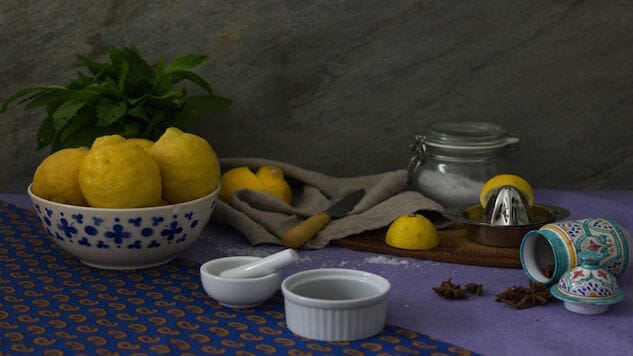Preserved Lemons are Magic
Photos: Giulia Pines
It took me far too long to realize just how many of my problems could be solved by preserved lemons. I live in Germany, where finding fresh veggies (and people who appreciate and know how to cook them) isn’t exactly easy. Most home chefs have a few simple tricks up their sleeves; douse just about anything with olive oil, salt and pepper and stick it in the oven, and it will come out somewhere along the spectrum of edible to tasty. But I needed something more than that — something that would take dishes from dull to divine. In short, I needed a little magic.
I first happened upon preserved lemons the way most — ahem — Westerns probably do: through the cuisine of North Africa. I’d been to Morocco on a whirlwind cooking and market foraging expedition with a group of overzealous chefs, foodies and food industry professionals, and something unexpectedly delicious gleamed through in a bite of tagine. Like most Americans, it had never occurred to me to pickle anything other than tiny green cucumbers, but once I realized what pickled citrus fruit could do to a simple stew, it opened up the door to pickling just about everything I could get my hands on.
As with many of civilization’s best culinary inventions, no one quite knows where the pickled lemon came from, but, like the holy grail of cooking, there are plenty who seek to claim it as their own. Egypt, Israel, Iran and Turkey – all have had some contact with preserved lemons over the centuries, and they’ve even taken a turn for the Provençal, ending up in dishes on the north as well as south shores of the Mediterranean. There are stories of Ancient Greek amphorae, as tall as full-grown men, packed to the brim with salted lemons and replenished every time their supply got too low. (No word on how the age-old lemons at the bottom of the vessel fared, but no doubt they had a deliciously deep, fermented funk, and I envy those Greeks who were lucky enough to scrape the bottom of that particular barrel.) Then, of course, there are those cookbooks and traveler’s tales that speak of simple dishes with a barely detectable note of something unusual, much like that first tagine I had on a terrace in Marrakesh.
Like most pickles and fermented foods, preserved lemons have the disadvantage of appearing extremely daunting to make. I live in Germany though, so if I wanted to add them to my own home cooking repertoire, I’d simply have to make them myself. Living in a foreign country has a way of making a cooking expert out of the most lazy and insecure people, and I was no exception. I looked at the day ahead of me, and saw hours of asking around at local supermarkets, only to be met by blank looks, compared with only a short amount of time in the kitchen, handling ingredients I already had at home. You see, preserved lemons may seem daunting at first, but that’s only your squeamishness (or perhaps, lack of patience) about putting something in a jar and leaving it for months. Think of the Greeks — they would have approved.
How to make them
How many lemons you need will depend on what type and size of jar you’re using. I
recommend the pretty Weck jars for maximum Instagrammability, or the heavier, more substantial latch lid jars. You’ll need several organic lemons (these are the ones you’ll preserve) and about twice as many non-organic lemons (these are the ones you’ll juice).
Sanitize the jar by your method of choice. The oven method (open jars in the oven at around 225 degrees Fahrenheit for about 20 minutes) is the cleanest and most straightforward. Juice your non-organic lemons and set the juice aside. Give your organic lemons a wash and cut them in half horizontally. Then, make a cross through each one, slicing almost down to the tip but not quite, so that the lemon half now has four quarters still somewhat joined together. Salt the lemon halves liberally, and stuff them down into the bottom of the jar.
Repeat until you’ve filled the jar, then add a layer of salt, the juice from the non-organic lemons and even more salt. Here’s where you can get creative, using whatever combination of spices you’d like. Some recipes call for roasting your spices lightly in a pan to release their aromas, but you can also forgo this step, choosing to bruise them a bit in a mortar and pestle instead. Coriander, fennel seeds, mustard seeds, star anise, bay leaf — add whatever you want to create complexity of flavor and make the jar look pretty.
